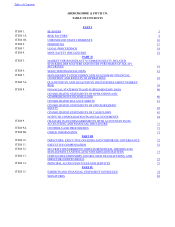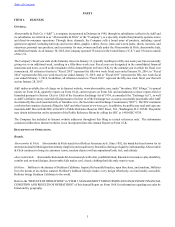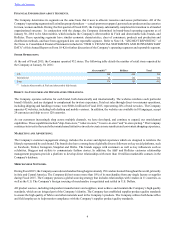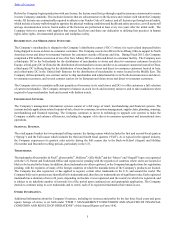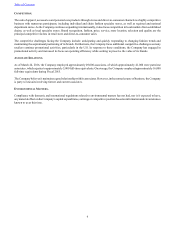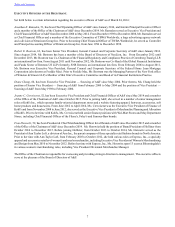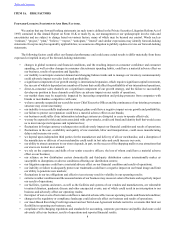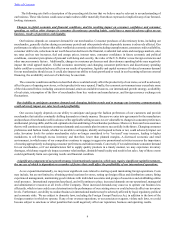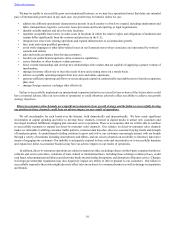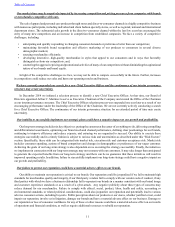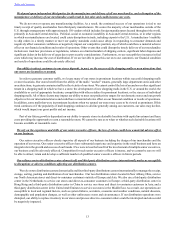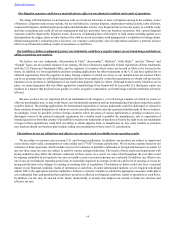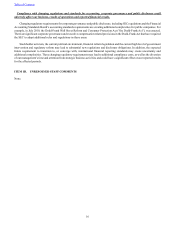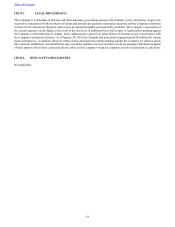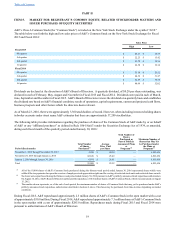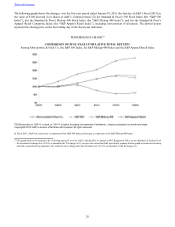Abercrombie & Fitch 2015 Annual Report Download - page 12
Download and view the complete annual report
Please find page 12 of the 2015 Abercrombie & Fitch annual report below. You can navigate through the pages in the report by either clicking on the pages listed below, or by using the keyword search tool below to find specific information within the annual report.
Table of Contents
12
Our business could suffer if our information technology systems are disrupted or cease to operate effectively.
We rely heavily on our information technology systems to operate our websites; record and process transactions; respond to
customer inquiries; manage inventory; purchase, sell and ship merchandise on a timely basis; and maintain cost-efficient operations.
Given the significant number of transactions that are completed annually, it is vital to maintain constant operation of our computer
hardware and software systems and maintain cyber security. Despite efforts to prevent such an occurrence, our information
technology systems may be vulnerable from time to time to damage or interruption from computer viruses, power outages, third-
party intrusions, inadvertent or intentional breach by our employees and other technical malfunctions. If our systems are damaged,
or fail to function properly, we may have to make monetary investments to repair or replace the systems, and we could endure
delays in our operations.
While we regularly evaluate our information technology systems and requirements, we are aware of the inherent risks associated
with replacing and modifying these systems, including inaccurate system information, system disruptions and user acceptance
and understanding. Any material disruption or slowdown of our systems, including a disruption or slowdown caused by our failure
to successfully upgrade our systems, could cause information, including data related to customer orders, to be lost or delayed.
Such a loss or delay, especially if the disruption or slowdown occurred during our peak selling seasons, could have a material
adverse effect on our results of operations.
We may be exposed to risks and costs associated with cyber-attacks, credit card fraud and identity theft that would cause us
to incur unexpected expenses and reputation loss.
In the standard course of business, we process customer information, including payment information, through our stores and
direct-to-consumer programs. Rapidly evolving technologies and types of cyber-attacks may result in this information being
compromised or breached. The retail industry in particular has been the target of many recent cyber-attacks, and as a result, there
is heightened concern over the security of personal information transmitted over the Internet, consumer identity theft and user
privacy. We endeavor to protect consumer identity and payment information through the implementation of security technologies,
processes and procedures. It is possible that an individual or group could defeat our security measures and access sensitive customer
and associate information. Actual or anticipated cyber-attacks may cause us to incur increasing costs, including costs to deploy
additional personnel and protective technologies, train employees, and engage third-party experts and consultants. Exposure of
customer data through any means could materially harm the Company by, but not limited to, reputation loss, regulatory fines and
penalties, legal liability and costs of litigation.
Fluctuations in foreign currency exchange rates could adversely impact our financial condition and results of operations.
The functional currency of our foreign subsidiaries is generally the local currency in which each entity operates, while our
consolidated financial statements are presented in U.S. Dollars. Therefore, we must translate revenues, expenses, assets and
liabilities from functional currencies into U.S. Dollars at exchange rates in effect during, or at the end of the reporting period. In
addition, our international subsidiaries transact in currencies other than their functional currency, including intercompany
transactions, which results in foreign currency transaction gains or losses. Furthermore, we purchase substantially all of our
inventory in U.S. Dollars. As a result, our sales and gross profit rate from international operations will be negatively impacted
during periods of a strengthened U.S. dollar relative to the functional currencies of our foreign subsidiaries, as was the case in
Fiscal 2015. Additionally, tourism spending may be affected by changes in currency exchange rates, and as a result, sales in our
flagship stores and other stores with higher tourism traffic have, at times, been adversely impacted, and may continue to be adversely
impacted, by fluctuations in currency exchange rates.
Fluctuations in the cost, availability and quality of raw materials, labor and transportation, could cause manufacturing
delays and increase our costs.
Fluctuations in the cost, availability and quality of the fabrics or other raw materials used to manufacture our merchandise
could have a material adverse effect on our cost of sales, or our ability to meet customer demand. The prices for such fabrics
depend largely on the market prices for the raw materials used to produce them, particularly cotton, as well as the cost of compliance
with sourcing laws. The price and availability of such raw materials may fluctuate significantly, depending on many factors,
including crop yields and weather patterns. Such factors may be exacerbated by legislation and regulations associated with global
climate change. In addition, the cost of labor at many of our third-party manufacturers has been increasing significantly, and as
the middle class in developing countries continues to grow, it is unlikely such cost pressure will abate. The Company is also
susceptible to fluctuations in the cost of transportation. We may not be able to pass all or a portion of higher raw materials prices
or labor or transportation costs on to our customers, which could adversely affect our gross margin and results of our operations.


